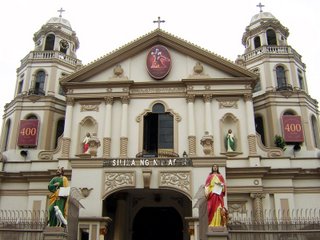
Quiapo Church, also known as the Minor Basilica of the Black Nazarene, is the site of the annual January Black Nazarene procession. One of Manila’s most famous churches, Quiapo Church gets very crowded every Friday when thousands of devotees come to light a candle in supplication to the Black Nazarene, a life-size image of Christ believed to be miraculous. Around the church is a fascinating gathering of vendors selling candles and curiosities like amulets and folk cures for obscure ailments. The present cream-colored edifice was built after the original Mexican Baroque structure burned to the ground in 1928.
Quiapo is a district of Manila, Philippines, also referred to as the "old downtown". It is known for its cheap prices on items ranging from electronics, bicycles to native handicrafts.
Quiapo is also famous for the Black Nazarene. Thousands of people parade through the streets to touch the statue where it is supposed to produce miraculous effects. A number of faithful usually collapse in a faint during the ritual, and some have even died. The Feast Day of the Black Nazarene (also known as Quiapo Day) is celebrated every January 9th.
Plaza Miranda in the heart of Quiapo District, is named after Jose Sandino y Miranda, who served as secretary of the treasury of the Philippines for 10 years beginning in 1853. It is a square or a public plaza in front of the St. John the Baptist Church or Quiapo Church as it is widely known. It is also a popular site of political rallies.
The Quiapo district is also home to a sizable Muslim population in Manila, and The Golden Mosque is located there. A veritable army of fortune tellers and stores offering herbal products surround the Quiapo church. The biggest problem underlying the district is piracy and bandits. The largest area where you can buy pirated movies, software and pornographic videos can be found in Quiapo where the stores sprawl over four public streets.
Through the years, the glory of Quiapo steadily declined. During the American period until the late 70s, Quiapo and its surrounding vicinities like Avenida, Binondo, Sta. Cruz, Escolta and the university belt, were the centers of trade, fashion, art, higher learning and the elites of Manila, however as the Light Rail Transit (LRT Line 1) run over the Rizal Avenue, the main thoroughfare of Avenida, dirt and vehicle emissions were trapped underneath, leaving the streets dark and gloomy. The results of this development were the exodus of many establishments and the arrival of ruffians and bandits. After the People Power Revolution in 1986, the vibrancy of Quiapo diminished, although some flea markets, handicraft stores begin to rise due to the presence of the widely visited Quiapo Church.
Quiapo is geographically located at the very center of the city of Manila. It is bounded by Estero de San Miguel on the South, San Miguel District on the East, Claro M. Recto Avenue on the North and Quezon Boulevard on the West.







0 Comments:
Post a Comment
<< Home